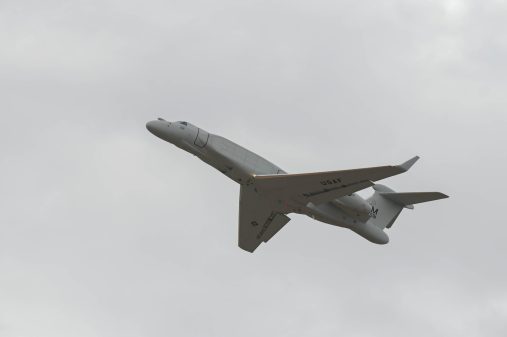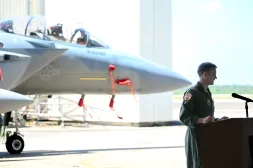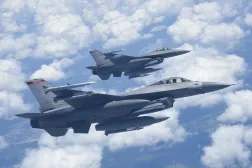
The Air Force received the first EA-37B Compass Call aircraft at Davis Monthan Air Force Base, Arizona, last week to train pilots, as the U.S. military moves to upgrade its electronic warfare arsenal.
Contractor BAE Systems delivered the first 10 airframes to the Air Force last September for system developmental testing, but this recent delivery marks the first system ready for pilot training. The platform is designed to jam enemy systems.
“For a pilot, there is nothing better than picking up a brand new aircraft from the factory and delivering it to the warfighters. For those of you who are going to get to fly it, it’s going to be amazing,” Gen. Ken Wilsbach, commander of Air Combat Command said in a statement. “We are on the cusp of delivering advanced capability, especially in electronic combat, and today is an exciting day for Air Combat Command.”
The delivery marks a key milestone in the Air Force’s journey to modernize its capabilities in the electromagnetic spectrum for so-called great power competition against sophisticated nation-states like China and Russia. While the legacy EC-130H Compass Call provided important capabilities such as message delivery from an information operations standpoint and jammed improvised explosive devices during the global war on terror, the threat in the electromagnetic spectrum has increased exponentially in recent years.
The Air Force decided to revamp the system with improved capability and a smaller Gulfstream G550 airframe — initially calling it the EC-37B Compass Call until is was redesignated the EA-37B Compass Call in October 2023 to better articulate its electronic attack mission. The new airframe provides increased range, speed and agility versus the larger legacy platform. Additionally, technology refreshes and a software baseline make the jamming capability much more lethal as it can process many more and diverse targets than its predecessor.
It is expected to be a critical tool in the joint force’s arsenal — alongside other airborne electronic attack platforms such as the Navy’s Next Generation Jammer program — denying adversary tactical networks and information ecosystems.
Notably, the Compass Call degrades and disrupts adversary communications, information processing, navigation, radar systems and radio-controlled threats while also employing offensive counter-information and electromagnetic attack capabilities, the Air Force said.
“The EA-37B is the right choice right now because as we continue to pivot toward Great Power Competition, we have adversaries that are developing long-range kill chain ecosystems and anti-access area denial capabilities,” Lt. Gen. Thomas Hensley, commander of 16th Air Force, the service’s information warfare command, said in a statement. “The Compass Call will allow us to do things in the non-kinetic spectrum as well as the electromagnetic spectrum to give us the advantage and not them.”






